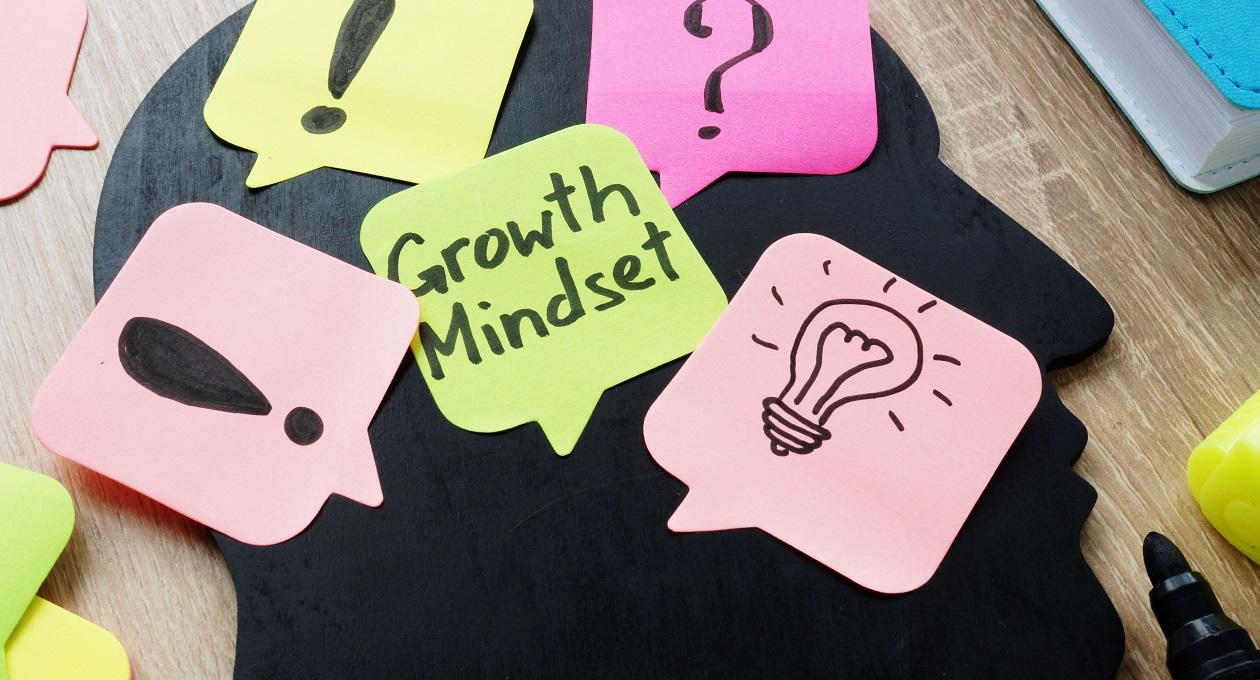From the world of sports to high-performing business stars, the idea of mindset is not a new concept but in today’s fast paced world where business success is just as important as business survival, developing the right mindset across your business and through your staff is essential.
We’ve all experienced the kind of managers who believe that “you either sink or swim” and some of us have been fortunate enough to have managers who believe that “you can constantly learn, grow and adapt to challenges.”
The latter of the two is a manager or potentially a leader who understands the importance of a growth mindset. From psychological studies to business examples all around the world, developing a growth mindset is a key component of not only motivating and engaging your employees, it can deliver results on the bottom line as well.
In this guide we are going to take a closer look at what a growth mindset is, what the main attributes are to a growth mindset, the benefits in the workplace and how to develop a growth mindset in your organisation.
What is a growth mindset?
A growth mindset is a way of seeing problems and skills gaps that can be overcome with time, patience and development. The term, “growth mindset” was originally coined by Carol Dweck, a psychologist, professor, and researcher at Stanford University, in her 2006 book Mindset: The New Psychology of Success.
At the time of its publication it showed that a person demonstrates a growth mindset when they believe they’re not limited by inherent traits or abilities. Instead, they have the capacity to learn, grow, and improve.
Talent alone does not create success but moreover, it is experience and applied practice that does - these are the ideas behind a growth mindset.
The author Matthew Syed in his book, Bounce, uses the studies from Carol Dweck on growth mindset to dig into the notion of “inherent abilities” and shows throughout his publication that those who have a growth mindset have generally achieved more in their careers than those who have what is termed as a fixed mindset. Even great sportspeople who appear to be naturally gifted are actually more likely to have a growth mindset as they will practise longer, harder and with the correct instruction to overcome obstacles in their chosen sport.
We have touched upon the fixed mindset but what are the differences between a growth and fixed mindset?
Growth mindset vs fixed mindset
Those with a fixed mindset believe that they are born with traits, talents, and qualities that are “fixed”, and that no course of training or adaptability can change those traits. It is normal for many people to assume that this is the case, that talent and abilities are something of which we are naturally good at or something which we are not.
Those with a fixed mindset generally struggle to change their viewpoints or find it difficult to commit to change, evolve and improve as they are under the impression that no matter what they do, little will change anyway.
In this type of scenario we are not thinking in terms of fixed traits but moreover, a fixed mindset.
On the other hand, there is the growth mindset, which looks at this from a different perspective. Abilities and talent are considered to be something that can be developed through dedication and hard work. Someone with a growth mindset may think, I’m not a great salesman yet because I haven’t put in the hours of practice, like someone who is a great performer.
People with growth mindsets are continuously open to setting new goals, trying new tactics, and improving their skills. As a result, these individuals are engaged in their work.
Main attributes of a growth mindset environment
In order to have more individuals in your organisation with a growth mindset, you need to develop the right kind of environment. This means that you must promote the idea that anyone can succeed if they apply the right strategies, work hard and ask for help to improve.
What do the various notable attributes of a growth mindset work environment look like? Here are just a few suggestions.
- Hard work, determination and perseverance are valued over talent
Rather than reward or use language which talks about natural talent, talk about the hard work that has been put into the task and workplace. Reward those who have demonstrated perseverance and determination to complete their goals.
- Employees are helped and encouraged to learn new skills
Setting goals which may be out of reach to begin with can develop employees to try new tactics, evolve their practices and minds and ask those who have achieved them for advice.
- Staff are coached and supported in developing critical thinking skills enabling them to deal with challenging issues
Develop learning resources, have open table discussions, monitor those who need help to learn and grow accordingly.
- Personnel are encouraged to experiment and try new ideas
“No idea is a bad idea” attitude. Test new things, new platforms, ideas, knowledge to overcome obstacles.
- Staff see failures as valuable learning opportunities
Rather than chastise staff who may not have hit the target, positively discuss what can be learnt from the failure and what can be done to turn it into a learning moment for the employee.
- Staff feel empowered and happy to take responsibility for their actions and own up to mistakes
A sure sign that the growth mindset has taken place is when staff openly own up to mistakes as they can see this as a learning opportunity.
- Staff are encouraged to speak up and respect diverse and possibly challenging viewpoints
Nothing is off limits in terms of learning, evolving and growing but equally, viewpoints should be challenged openly and respected.
Benefits of a growth mindset in the workplace
We need to understand that a growth mindset in the workplace can carry many benefits, and that having individuals with a growth mindset over say, a fixed mindset can make both learning and development within the organisation a better experience for everyone involved.
These benefits of having a growth mindset include:
- Improved problem solving
- People with growth mindsets are more likely to see problems as interesting challenges from which they will learn something.
- They will also use lateral thinking as part of their problem solving strategies, picking ideas from different areas because they’re not afraid to try new things.
- Perseverance and tenacity
- People with a growth mindset are more likely to keep on trying and are less likely to give up at the first hurdle.
- Greater creativity
- It is not uncommon to see that a growth mindset and creativity are closely linked.
- Rather than using an idea to say, “I can’t achieve this” a growth mindset will say, “what other ways have I not looked at this issue?” and come up with something “left field” in response.
- Divergent thinking to problem solving increases creativity and equally enhances the growth mindset paradigm.
- Also - creativity can enhance efficiency - which saves money and other resources.
- Change in perspective
- As noted in the comparison between growth and fixed mindsets - the perspective of a growth mindset recognises that growth is about the journey more than the destination.
- Greater trust
- Those with fixed mindsets, who believe their capabilities and those of their workmates are set, are more likely to view colleagues as competitors - not collaborators.
- Corporate cultures rooted in fixed mindsets therefore demonstrate less trust.
- In workplaces with widely shared growth mindsets employees tend to find their workmates more trustworthy.
- Improved staff morale
- Employees at companies with growth mindsets are more likely to feel a strong sense of commitment to the organisation.
- If they see that their opinions are valued their morale and motivation is boosted.
How to develop a growth mindset in the workplace
The good news is that we can all develop a growth mindset in the workplace. Taking intentional steps to prioritise a growth mindset in the workplace can have major impacts on company culture, performance and workplace relationships which helps with engagement and productivity.
Here are some suggestions for developing a growth mindset in your workplace:
- Create learning opportunities
- Establish programs that enable staff to learn new skills.
- Consult with staff regarding what they want to learn or know more about.
- Use in house expertise to cross-train between departments.
- Use technology (e.g. mobile based) to deliver training and learning resources in accessible, appealing formats.
- Use the right recruitment messaging
- When hiring - don’t refer to the best and the brightest, talk about opportunities to grow, develop and learn.
- Reward people for their hard work, their strategies, their ability to tackle challenges and for their perseverance.
- Consider both successes and failures as valuable learning opportunities
- Celebrate failures as learning opportunities.
- Encourage a growth mindset in the workplace by celebrating failures as part of the learning process and treating them as a source of valuable data on what worked (and what didn’t).
- Avoid Group Thinking
- It is important to note that a fixed mindset leads to groupthink, a tendency to conform to ideas and beliefs with conservative thinking - which leads to poor decision making.
- Instead, create ways to foster alternative views and constructive criticism.
- Relate staff performance evaluation to learning and not productivity
- Traditional employee performance appraisals might look at levels of output or productivity but, changing this to examine how employees are growing and developing contributes to establishing an organisational growth mindset.
- Encourage and facilitate open and honest sharing
- Leaders with growth mindsets are open to hearing other perspectives, even when they challenge their own.
- Providing the facilities for all employees to make contributions, share ideas and present criticisms contributes to the development of an organisation’s growth mindset.
- Invest in staff development, training and learning
- Companies with growth mindsets know that the full potential of their employees has not yet been realised.
- Describe how investing in upskilling, reskilling, mentoring, coaching and other forms of staff development plays a huge part in establishing a beneficial growth mindset.
Improving your businesses growth mindset
We all have the ability to learn, grow, evolve and develop. By doing so we can overcome obstacles through time, perseverance and become better employees as well as better people. This is the basis of a growth mindset, and by taking on this vision over something such as a fixed mindset which only looks to reward “inherent ability”, we can create better working conditions and help individuals grow in their role.
From better problem solving, more creative thinking and developing trust in the workplace, a growth mindset can be a critical key in your overall success.
Thomas assessments and tools can help you identify individuals with a growth mindset and develop appraisals and evaluations focused on development, learning and growing over more traditional metrics.
If you would like to learn more, please speak to one of our team.




